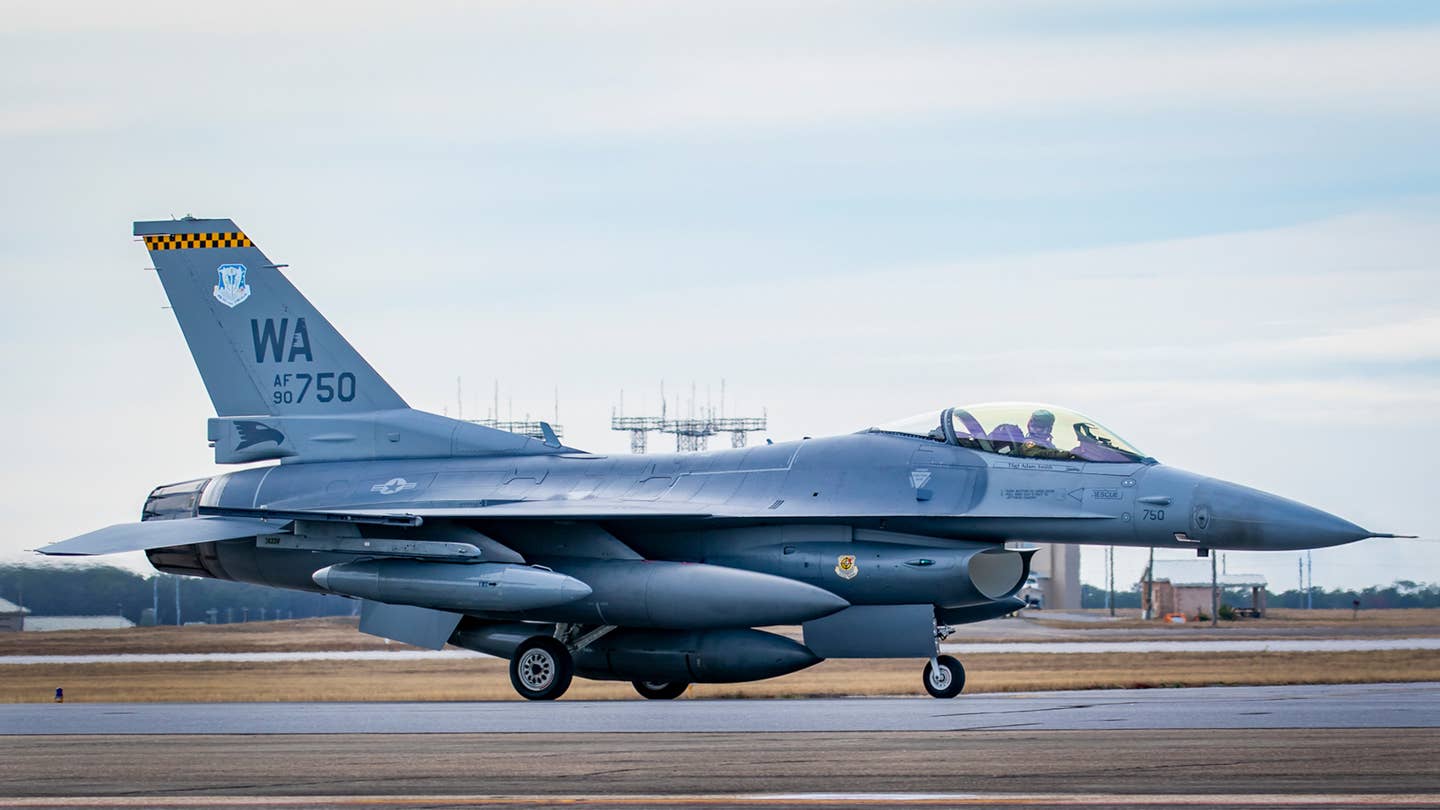Air Force Secretary Plans to Get in Cockpit of Self-Flying Fighter Jet
The Air Force is building an army of artificial intelligence-powered warfighters, each of which will command a fleet of small, buzzing drones.

An F-16 fighter jet arrives at Eglin Air Force Base in Florida to be modified for autonomous flight testing. [Courtesy: U.S. Air Force]
During a Senate hearing on Tuesday, Air Force secretary Frank Kendall told U.S. lawmakers he will get in the cockpit of an artificial intelligence-controlled fighter jet.
Kendall said the flight is intended to allow him to observe the technology underlying the Air Force’s future fleet of Collaborative Combat Aircraft (CCA), which will pair crewed jets with fleets of tiny, buzzing, autonomous drones. A second pilot will join the Air Force secretary, but neither will actually fly the aircraft—a modified F-16—except in case of emergency.
The U.S. is investing plenty of money into the CCA. According to the Associated Press, the Air Force requested $559 million in its upcoming budget to support the program, out of a total budget request of $188.1 billion. The department’s 2025 fiscal year begins October 1. For the 2024 defense spending bill, the U.S. Department of Defense requested $1.8 billion worth of artificial intelligence investments.
“We have a cost problem with the aircraft that we're buying now,” Kendall said in response to a question from Senator Susan Collins (R-Maine), vice chair of the Senate Appropriations Committee, during a hearing for the Air Force and Space Force fiscal year 2025 budget request. “Our fighters are very expensive. The F-35 and the F-15EX cost about $100 million each, NGAD (Next Generation Air Dominance) will cost over $300 million and will be bought in small numbers.
“The uncrewed Collaborative Combat Aircraft give us an opportunity to address the cost and the quantity issues with relatively inexpensive but very highly cost-effective platforms that we add to the fleet.”
The Air Force earlier this month welcomed three F-16s to Eglin Air Force Base (KVPS) in Florida, where they will be modified for autonomous testing. The modifications are part of the Viper Experimentation and Next-gen Operations Model-Autonomy Flying Testbed program, or VENOM-AFT, which supports CCA with funding for autonomous software testing on crewed and uncrewed aircraft.
VENOM-AFT testing will be performed by the Air Force’s 40th Flight Test Squadron and 85th Test and Evaluation Squadron. Personnel will monitor the autonomy system during flight and provide feedback.
Additionally, the Air Force Research Laboratory this month received a $4 million grant to build an AI and machine learning research center at Wright-Patterson Air Force Base (KFFO) in Ohio.
Kendall’s comments on Tuesday come amid the backdrop of China’s rising military might, particularly in the air.
Drones manufactured in China have been spotted on the battlefield in Eastern Europe and the Levant, where they have inflicted devastating attacks on troops, infrastructure, and civilians. Chinese manufacturer DJI is considered the largest seller of consumer drones. But many cheaply bought DJI products have been modified for use in combat, prompting wariness among U.S. lawmakers.
Kendall urged senators to modernize the department’s technology, warning that any further budget delays could give China a leg up. The budget for the current fiscal year was enacted in March, more than six months later than intended.
“Time matters, but so do resources,” Kendall said. “The United States is also now facing a competitor with national purchasing power that exceeds our own, a challenge we have never faced in modern times.”
Beyond the CCA, the DOD is also building up an army of “small, smart, cheap” drones through the Replicator initiative, announced by Defense Secretary Kathleen Hicks in August.
According to Hicks and other senior officials, the plan is to produce “multiple thousands” of systems that are attritable, meaning they could be lost or shot down with minimal impact to U.S. military capabilities. These drones would be ideal for high-risk operations in which the chance of a crash or takedown is likely.
Hicks said the objective is to “outmatch” China. But William LaPlante, undersecretary of defense for acquisition and sustainment, clarified that Replicator systems will be distinct from CCA aircraft. However, LaPlante added that Replicator drones could be “very complementary” to the CCA initiative.
Like this story? We think you'll also like the Future of FLYING newsletter sent every Thursday afternoon. Sign up now.

Subscribe to Our Newsletter
Get the latest FLYING stories delivered directly to your inbox






